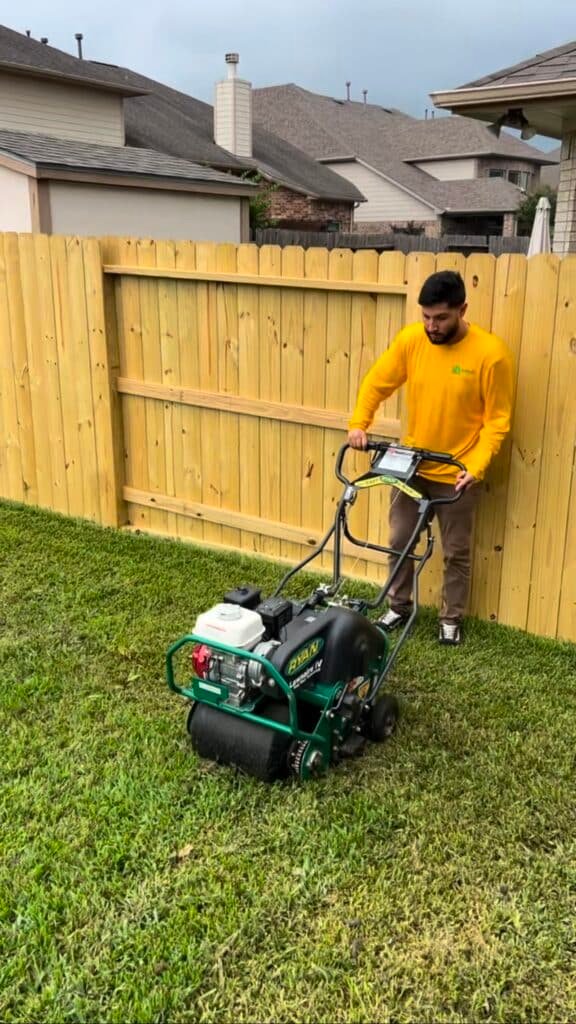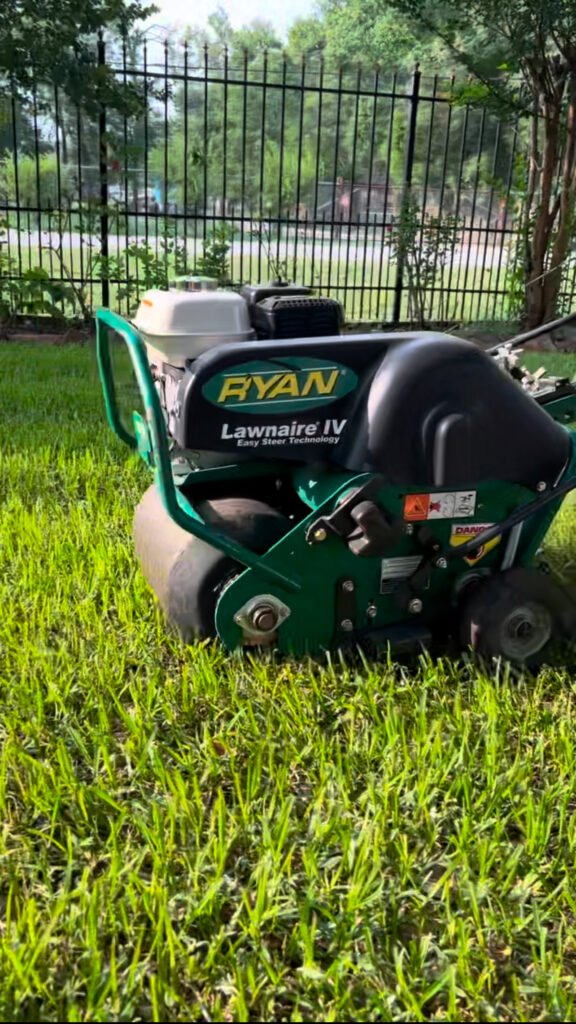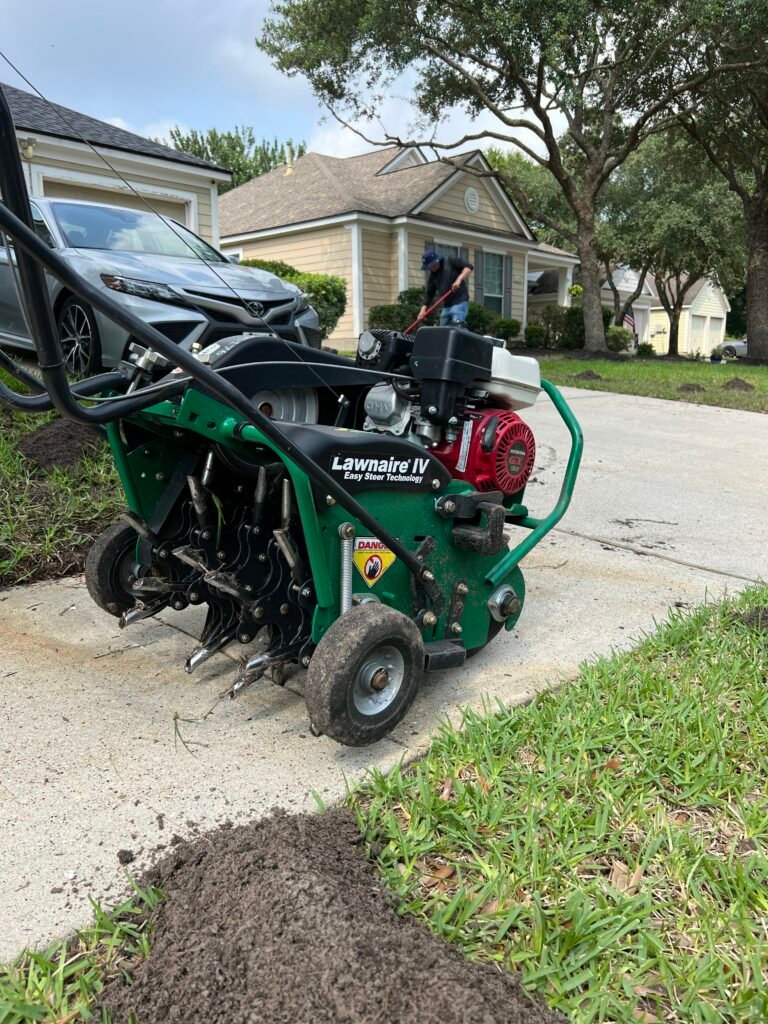Picture this- It’s late May in Houston, and the temps are already soaring into the 90s. We’ve had a few heavy rains earlier in the month, leaving the soil compacted and prone to pooling. Meanwhile, your St. Augustine grass struggles to stay vibrant and green, despite regular watering.
The culprit? Soil compaction. In today’s blog, we’ll show you how aeration can transform your lawn from drab to fab, even in Houston’s challenging climate.
Quick Local Fact: According to Harris County Extension resources, much of our region’s soil contains significant clay content, making aeration critical to ensure water and nutrients get where they need to go: the root zone.
What is Aeration, and Why Does It Matter?
Aeration is the process of creating small holes in your lawn to relieve soil compaction, allowing air, water, and nutrients to penetrate the root layer. There are a few different techniques available:
-
Core Aeration – Recommended
A specialized machine removes small plugs (cores) of soil. This method is especially effective for clay-heavy or heavily trafficked lawns, as it physically removes compacted soil and opens up space for roots. -
Spike Aeration – Not recommended
Solid tines create openings in the ground without extracting plugs of soil. While this approach is simpler and less expensive, spike aeration can be less effective in Houston’s dense clay soils because the surrounding soil often becomes further compacted around each hole. -
Liquid Aeration – Depends on your needs
This involves applying a solution designed to condition the compacted soil and improve water penetration. It’s often more cost-effective and easier to apply than mechanical aeration methods, but it generally doesn’t deliver the same level of immediate relief as core aeration.
When soil is aerated—grass roots can expand deeper, drawing in more nutrients and water. That alone can dramatically improve your lawn’s resilience during scorching summer days and heavy storms.
How Houston’s Climate Affects Your Lawn
- Heat and Humidity: Our subtropical climate accelerates soil compaction. The hotter it gets, the more your lawn relies on deep, healthy roots to pull water from the soil.
- Heavy Rainfall: Houston averages around 50 inches of rain each year, with downpours that can lead to water runoff instead of absorption—especially when the ground is rock-hard.
- High Foot Traffic: Whether it’s kids playing tag or weekend BBQs, everyday activity adds to compaction. Over time, that pounding locks your soil tighter, restricting root growth.
Aeration works as a pressure-relief valve: it releases that pent-up compaction so your lawn can breathe again.
Personal Anecdote – A Lawn Transformed
Last summer, our team helped a homeowner in Kingwood who was dealing with bald spots and persistent standing water. After performing core aeration and applying a slow release fertilizer, we saw a promising change. Within a couple of months, most of the previously bare areas had filled in, and with proper follow-ups and maintenance, the lawn was well on its way to becoming one of the best-looking yards on the block!
6 Key Benefits of Aeration for Houston Lawns
-
Deeper Root System
Removing small plugs of soil gives roots space to stretch. Healthier, deeper roots enable your turf to stand firm against drought and foot traffic. -
Optimal Nutrient Intake
Fertilizers can’t work their magic if they never reach the roots. Aeration ensures nutrients seep down where they’re most needed. -
Reduced Thatch Accumulation
Thatch is a layer of dead grass and debris. Aeration breaks it up, promoting healthy airflow and better water penetration. -
Better Water Percolation
After aeration, water can seep deep rather than pool on the surface. That cuts down on water waste and helps your lawn handle rainfall more efficiently. -
Improved Resistance to Disease & Pests
A robust root system and balanced soil environment create a lawn less susceptible to fungus, grubs, and other pest problems. -
Lusher, Greener Appearance
Aeration literally helps your lawn “breathe.” When grassroots are well-oxygenated and nourished, you’ll see a thicker, greener carpet of grass.
Houston Lawn Aeration Guide – Best Times to Aerate
- Late Spring to Early Summer
This is ideal for warm-season grasses like Bermuda, St. Augustine, and Zoysia. The active growth during these months ensures faster recovery from aeration.- Early Fall
If you miss spring or have a cool-season variety, early fall can still boost root health before cooler weather sets in.- Year-Round Considerations
Technically, aeration can be done throughout the year to tackle drainage and compaction issues. However, if you plan to aerate in winter, be mindful of freezing temperatures—dormant or semi-dormant grass can be stressed by extreme cold immediately following aeration.Pro Tip: Aeration works best when the soil is slightly moist (but not soggy), so aim for just after a moderate rain or a light watering. If your soil is extremely compacted, two rounds of aeration—one in spring and one in fall—may give you optimal results.
Our Core Aeration Process
-
Lawn Inspection & Soil Analysis
We check for thatch thickness, soil moisture levels, and any hidden trouble spots, such as fungal growth or pest activity. -
Pre-Aeration Prep
We recommend mowing a bit shorter than usual and clearing the yard of toys, furniture, and debris. Additionally, if you have sprinklers in the lawn, make sure to mark them with flags to avoid damage. -
Core Aeration
Using commercial-grade equipment, we pull out small plugs of soil about 2–3 inches deep and 0.5–0.75 inches in diameter. -
Plug Dispersal & Decomposition
The plugs naturally decompose over the following weeks, returning nutrients to the soil’s surface. -
Follow-Up Care
After aeration, our specialists may apply fertilizer to give the newly invigorated roots a boost. Proper watering is crucial during this time to help the lawn recuperate and fill in the holes.
FAQs – Addressing Your Lawn Aeration Concerns
Will My Lawn Look Messy After Aeration?
Expect to see small plugs of soil on the surface—it may look rough for a week or so. Don’t worry: these plugs break down quickly, leaving a smoother, healthier lawn.
Do I Need to Reseed?
First, determine your grass type and whether it can be grown from seed. For example, St. Augustine grass is typically propagated only through sod or plugs, so seeding it with another grass type will lead to an uneven, mismatched lawn. However, if your grass type can be seeded and you’re dealing with bare spots, seeding right after aeration is highly effective: the aeration holes serve as protected pockets for the seeds, ensuring better soil contact and faster germination.
How Often Should I Aerate?
- Annually or Two Times a Season for high-traffic lawns or clay-heavy soil.
- Annually or Every Other Season if your yard is in relatively good shape and doesn’t see a ton of foot traffic.
Can I Aerate on My Own?
Renting a machine is possible, but they’re heavy, and improper use could damage your lawn or underground utilities. Furthermore, after the cost of renting the tool, gas, and your time, you’re often close to—or even over—the amount you’d spend for a pro service. Letting a professional handle it ensures a thorough, safe job.
Will Aeration Solve My Weed Problem?
Aeration itself isn’t a weed-control method, but it strengthens your lawn so weeds have less room to invade. Pair it with weed management and proper fertilization for best results.

Ready to Revitalize Your Lawn?
If you’re tired of wrestling with stubborn brown patches and poor drainage, aeration could be the answer. Contact us today for a free lawn assessment and customized aeration plan. Our team of Houston lawn experts is here to guide you from start to finish.
Bonus Tips – Combine Houston Lawn Aeration with Fertilization & Topdressing!
One of the best ways to supercharge the benefits of aeration is to follow it up with fertilization and topdressing. Right after the soil is loosened, nutrients can dive deeper into the root zone, making every application more effective.
- Fertilization: Post-aeration fertilization helps fill those aeration holes with a nutrient-rich mix, jumpstarting greener, denser growth.
- Topdressing: This involves adding a thin layer of organic material—usually compost, sand, or a soil blend—over the surface of your lawn. It further enhances soil structure, smooth’s out uneven patches, and promotes better drainage.
Stay Tuned: In our next blog, we’ll dive deeper into the topdressing process—why it matters, how it complements aeration, and the best materials for Houston’s varying soil profiles.
Taking Action for a Greener, Healthier Houston Lawn
Aeration isn’t just a one-time fix—it’s a fundamental part of a long-term strategy for a vibrant Houston yard. Pairing aeration with fertilization and topdressing will help your turf thrive through our scorching summers. But remember, reading is just the first step. To see real results, you’ve got to take action. Explore more of our free lawn care tips on the blog, where we share hard-earned insights from years of local trials and triumphs. We’re here to guide you every step of the way—reach out for a simple consult if you need individualized advice for your home.
Get in touch with us now to schedule your next aeration appointment. Let’s work together to make your Houston lawn the best on the block!


